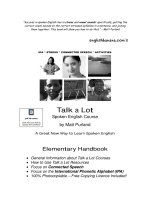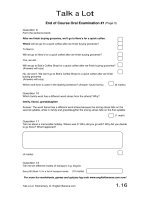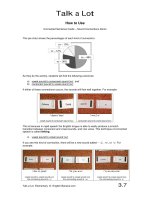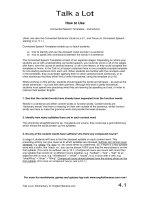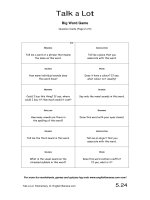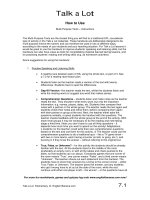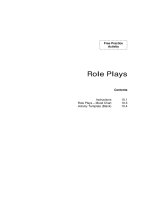Tài liệu Spoken english elementary handbook part 9 doc
Bạn đang xem bản rút gọn của tài liệu. Xem và tải ngay bản đầy đủ của tài liệu tại đây (149.58 KB, 15 trang )
Talk a Lot
How to Use
Multi-Purpose Texts – Instructions
For more fun worksheets, games and quizzes log onto www.englishbanana.com now!
Talk a Lot Elementary © English Banana.com
7.1
The Multi-Purpose Texts are the closest thing you will find to a traditional EFL coursebook-
type of activity in the Talk a Lot materials. These handouts are deliberately designed to be
multi-purpose (hence the name!) and can therefore be used in lots of different ways,
according to the needs of your students and your teaching situation. For Talk a Lot lessons it
would be great to use the handouts to improve students’ speaking and listening skills, but the
handouts can also have value as tools for consolidating material learned during lessons, and
for practising students’ reading and writing skills (e.g. as homework activities).
Some suggestions for using the handouts:
1. Practise Speaking and Listening Skills
• A reading race between pairs of SS, using the whole text, or part of it. See
p.7.2 for a reading race lesson plan.
• Students listen as the teacher reads a version of the text with twenty
differences. Students have to spot the differences.
• Gap-fill Version –the teacher reads the text, whilst the students listen and
write the missing word (or suggest any word that makes sense).
• Comprehension Questions – students listen and make notes as the teacher
reads the text. They shouldn’t write every word, but only the important
information, e.g. names, places, dates, etc. Students then compare their
notes with a partner or the whole group. The teacher reads the text again and
students check their notes and refine them, before comparing them again
with their partner or group at the end. Next, the teacher either asks the
questions verbally, or gives students the handout with the questions. The
teacher checks feedback with the whole group at the end of the activity. With
lower level groups it may be necessary to do the reading and note-taking
stage a third time. Note: you don’t have to use all thirty questions – it
depends how much time you want to spend on the activity! Adaptations:
i) students (or the teacher) could write their own comprehension questions
based on the text and use them for this activity. ii) The teacher could use the
comprehension questions to do a traditional quiz – like a TV game show –
with two or more teams, each having a buzzer (or bell, or gong, etc.!), and
buzzing in if they know the answer – without referring to the original text.
• True, False, or Unknown? – for this activity the students should be already
familiar with the text. All the students stand in the middle of the room
(preferably an empty room, or with all the tables and chairs pushed to the
sides, so that students can run about). Everybody agrees that one corner of
the room means “True”, one corner means “False”, and a third corner means
“Unknown”. The teacher shouts out each statement from the handout. The
students have to show their answers by running to the correct corner – either
True, False, or Unknown. The teacher gives the answer, and any students
who get it wrong have to sit out at the side of the room, while the rest
continue until either one player is left – the winner! – or the questions have all
Talk a Lot
How to Use
Multi-Purpose Texts – Instructions
For more fun worksheets, games and quizzes log onto www.englishbanana.com now!
Talk a Lot Elementary © English Banana.com
7.2
been used up. Adaptation: students (or the teacher) could write their own
True, False, or Unknown? statements based on the text before doing this
activity.
• Students imagine the scene and act it out (role play) – including what
happens before and after, and any scenes that are talked about in the text.
• Students take turns to read the text out loud; the teacher checks
pronunciation.
• Students learn the text by heart, with the teacher reading the beginning of
each sentence to prompt the students.
• The teacher dictates part or all of the text, whilst the students write it down.
The students check what they have written in pairs, then with the text, or they
listen again.
• Discussion: talk about the scene. Have the students ever experienced
anything like this? What do they think of the characters’ actions, feelings,
responses, etc.?
2. Practise Reading and Writing Skills
• Students translate the text into their first language(s).
• Gap-fill Version – students read and write the missing word (from a few
different options or any word that makes sense).
• Multiple Choice – Use of English – this is a classic homework activity, but
could also be done orally in class.
• Comprehension Questions – students write the answers in full sentences
for homework.
• True, False, or Unknown? – students write the answers (T, F, or U) and
justify them with reasons from the original text.
• Students underline different parts of a sentence in the original text, e.g.
verbs, nouns, adjectives, etc.
• Students identify verb forms, etc.
• Students write the story in their own words (in English).
• Creative writing: students write “What happens next…”
• One student reads the text to their partner, who writes it down word for word.
Talk a Lot
How to Use
Reading Race – Lesson Plan
For more fun worksheets, games and quizzes log onto www.englishbanana.com now!
Talk a Lot Elementary © English Banana.com
7.3
Activity Type: Noisy, busy, active, yet focused
Level:
Elementary - Pre-Intermediate, depending on the level and length of
the text that you use
Skills:
Reading, Writing, Speaking, and Listening
Class Size:
Whole group lesson, e.g. ten students in a group
Time:
50 minutes
Aim:
To practise all of the skills – reading, writing, speaking, and listening;
to energise a lethargic class; to encourage pair work
Materials:
Board and pen; several copies of the text (including one for you)
Procedure:
1. Find a short text that’s suitable for the level of your group. I used the printable version of a
fun story from BBC News, which I found online.
2. Introduce the topic and pre-teach new vocab; try to elicit each new word. For example, in
this story I had to pre-teach “London Marathon”, “autographs” and “exertions”, as well as a
few more.
3. Put two (or more) copies of the text on the wall in different locations in the classroom.
Explain the task to the class. Students have to work in pairs and their aim is to make an
accurate copy of the text. One student goes to it, reads part of it, remembers it, then comes
back to tell their partner what they have read, while their partner has to write it down. So, one
partner is reading and speaking, and the other is listening and writing. Students should swap
roles from time to time during the activity. You could set a time limit, or let the activity flow
naturally. The important rules are:
a) students must not touch or move the text
b) students must not shout at each other across the class
c) the person who reads the text cannot write the story, and vice versa
4. When a pair has written the complete story they should read through their copy and check
it for grammatical and spelling mistakes. If necessary, one person can go back and check the
text on the wall and tell their partner how to make corrections.
5. Next, each pair has to write ten comprehension questions about the text for a different pair
to answer. The question types should be:
a) x4 wh- questions (e.g. what, who, where, when, etc.)
b) x4 yes/no questions (e.g. “Is...?”, or “Does...?” etc)
Talk a Lot
How to Use
Reading Race – Lesson Plan
For more fun worksheets, games and quizzes log onto www.englishbanana.com now!
Talk a Lot Elementary © English Banana.com
7.4
c) x2 true/false questions
6. Each pair swaps their questions with another pair and the students write answers to the
questions. The teacher leads group feedback at the end.
7. The students swap their version of the story with another team and the teacher reads the
story as it was printed on the handout. The students have to check the text in front of
them for mistakes. They give one point for each deviation from the original text, e.g. a missing
word or the wrong kind of article. The pair with the lowest number of points at the end is the
winning team!
8. Let the students see the original text so that they can compare it with their work.
9. Optional extension activity: the students have to write down a summary of the lesson: what
they did, what they learned, and how they felt about it.
Discussion Questions
Contents
Instructions 8.1
Activity Template (Blank) 8.2
Free Practice
Activity
Talk a Lot
How to Use
Discussion Questions – Instructions
For more fun worksheets, games and quizzes log onto www.englishbanana.com now!
Talk a Lot Elementary © English Banana.com
8.1
Students work in pairs, with student A asking student B the first question, then student B
asking student A the same question, before moving on to the next question. After between
5-10 minutes the students change partners and repeat the process with a different student.
Where there are empty boxes on the handout – for example questions 2, 4 and 7 on the
“Cars” Discussion Questions handout from Book 2 – the student should write down their
partner’s answers. This is partly to encourage the students to focus on the task in hand, and
partly so that the teacher, who should be monitoring all the pairs, can see written evidence
that the questions have been asked and answered. Depending on the level of the group,
before the students move off to work in pairs the teacher should look at the handout with the
whole group and ensure that everybody understands the task and vocabulary used in the
questions before they begin. For example, the teacher could pre-teach some of the more
difficult words and there could be a dictionary race to see which student finds each word the
fastest.
Extension activity: pairs that have finished the activity early could think up their own new
discussion questions based on the same topic, or the teacher could prepare additional
questions for the students, using the blank template on p.8.2.
At the end of the activity the whole group comes back together for group feedback, where the
teacher chooses different students to read a question and tell the class both their own answer
and their partner’s answer. The teacher should highlight errors that have occurred and elicit
the answers from the group. Interesting structures could be explored in more detail on the
board, if there is time.
Assessment
Assessment is performed by the teacher checking and correcting during the task, listening for
errors that can be dissected later on in a group feedback session, giving individual as well as
group feedback, and referring students back to:
a) the grammar they are learning from forming the sentence blocks, and building
sentences
b) the pronunciation work they are doing using the techniques of connected speech and
the IPA
Each student’s achievement in this activity is also recorded as part of their overall lesson
score (for both accuracy and effort) by the teacher on their course report.
